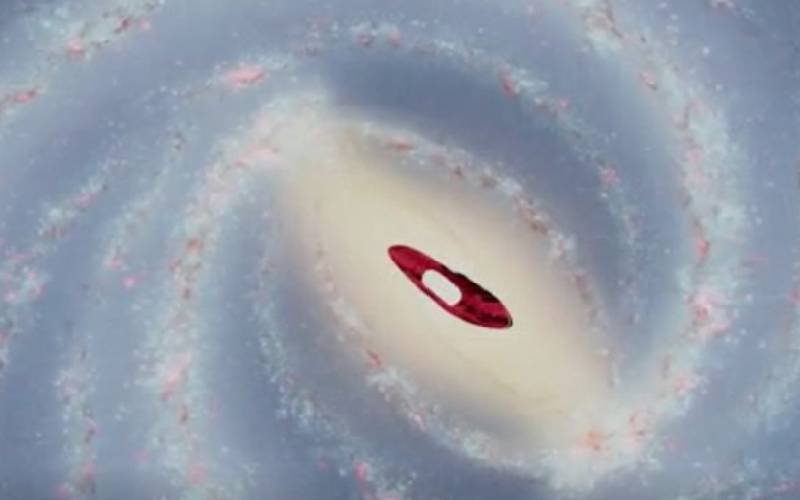
The Tilted Disk, named after its orientation, lies in the central bar region of the Milky Way
A mysterious red glow at the centre of the Milky Way has been detected for the first time.
It shines out of an area known as the 'Tilted Disk' - and could shed light on the fundamental source of our spiral galaxy's power.
Astronomers used WHAM (Wisconsin H-Alpha Mapper), a telescope based in Chile, to make the dramatic discovery.
The faint beacon is only just visible from Earth -peaking through a hole in the dust. It is a telltale sign of ionised hydrogen gas - coming from newly forming stars, say the US team.
They diagnosed the source by comparing other colours of visible light coming from ionised nitrogen and oxygen.
The Tilted Disk, named after its orientation, lies in the central bar region of the Milky Way.
It pulsates with hydrogen that has been ionised - stripped of electrons so it is highly energised.
Co author Dr Lawrence Haffner, of Embry-Riddle Aeronautical University, Florida, said: "Without an ongoing source of energy, free electrons usually find each other and recombine to return to a neutral state in a relatively short amount of time.
"Being able to see ionised gas in new ways should help us discover the kinds of sources that could be responsible for keeping all that gas energised."
His colleague Professor Bob Benjamin, of the University of Wisconsin-Whitewater, was looking at two decades' worth of WHAM data when he spotted the 'red flag'.
The peculiar shape poking out of the Milky Way's dark, dusty centre was ionised hydrogen gas which appears red - and was moving in the direction of Earth.
The position of the feature couldn't be explained by known physical phenomena such as galactic rotation.
Dr Haffner said: "Being able to make these measurements in optical light allowed us to compare the nucleus of the Milky Way to other galaxies much more easily.
"Many past studies have measured the quantity and quality of ionised gas from the centres of thousands of spiral galaxies throughout the universe.
"For the first time, we were able to directly compare measurements from our galaxy to that large population."
Lead author Dhanesh Krishnarao, a graduate student at University of Wisconsin-Madison, leveraged an existing model to predict how much gas there should be.
Raw data from the WHAM telescope allowed him to refine his calculations until the team had an accurate 3-D picture of the structure.
The study, published in the journal Science Advances, also found that around half of the hydrogen has been ionised by an unknown source.
"The Milky Way can now be used to better understand its nature," Mr Krishnarao said.
The gaseous, ionised structure changes as it moves away from the Milky Way's centre, Previously, scientists only knew about the non-ionised gas located in that region.
"Close to the nucleus of the Milky Way," Mr Krishnarao explained, "gas is ionised by newly forming stars, but as you move further away from the centre, things get more extreme, and the gas becomes similar to a class of galaxies called LINERs, or low ionisation (nuclear) emission regions."
The structure appeared to be moving toward Earth because it was on an elliptical orbit interior to the Milky Way's spiral arms, the researchers found.
LINER-type galaxies such as the Milky Way make up roughly a third of all galaxies. They have centres with more radiation than galaxies that are only forming new stars, yet less radiation than those whose supermassive black holes are actively consuming a tremendous amount of material.
LINER region
"Before this discovery by WHAM, the Andromeda Galaxy was the closest LINER spiral to us," said Dr Haffner.
"But it's still millions of light-years away. With the nucleus of the Milky Way only tens of thousands of light-years away, we can now study a LINER region in more detail. Studying this extended ionized gas should help us learn more about the current and past environment in the center of our Galaxy."
The researchers now plan to figure out the source of the energy at the centre of the Milky Way.
Being able to categorise the galaxy based on its level of radiation was an important first step toward that goal.
Dr Haffner added: "In the next few years, we hope to build WHAM's successor, which would give us a sharper view of the gas we study.
"Right now our map 'pixels' are twice the size of the full moon. WHAM has been a great tool for producing the first all-sky survey of this gas, but we're hungry for more details now."
 The Standard Group Plc is a multi-media organization with investments in media platforms spanning newspaper print
operations, television, radio broadcasting, digital and online services. The Standard Group is recognized as a
leading multi-media house in Kenya with a key influence in matters of national and international interest.
The Standard Group Plc is a multi-media organization with investments in media platforms spanning newspaper print
operations, television, radio broadcasting, digital and online services. The Standard Group is recognized as a
leading multi-media house in Kenya with a key influence in matters of national and international interest.











